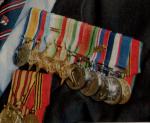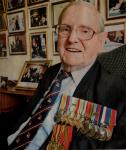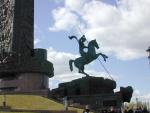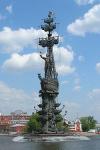-
Posts
3,939 -
Joined
-
Last visited
-
Days Won
1
Content Type
Profiles
Forums
Blogs
Gallery
Events
Store
Everything posted by Christophe
-
This week Bill Stone, one of Britain's last three veterans of WW1, died. He was the last vet having served in both World Wars. At the outbreack of WW2, Stone was the stocker chief petty officer of the minesweeper Salamander. In August 1941, Salamander provided close anti-submarineprotection to the first, and on this occasion, uneventful convoy to Russia (Murmansk) He had been awarded the Soviet Medal for 40th Anniversary of Victory in the Great Patriotic War, and its Russian version for the 50th anniversary. Here is an article published in the Daily Telegraph, dated 13 January 2009 : "Bill Stone, First World War veteran, dies aged 108 By Aislinn Simpson Bill Stone, one of the three remaining survivors of the First World War in Britain, has died at the age of 108. Mr Stone was born as one of 14 children in Devon in 1900 and at 16, joined the battle cruiser HMS Tiger which took him to the home of the navy's Grand Fleet at Scapa Flow before progressing to the battleship HMS Hood. During the Second World War as Chief Stoker of HMS Salamander, he took part in the evacuation of Dunkirk, making five trips to pick up troops from the beaches. He also served in the Sicily landings of 1943 with HMS Newfoundland, and was mentioned in despatches after a torpedo attack en route back to their base in Malta. A modest man, he chose to speak only rarely about the horrors he had seen, opting instead to focus on happier moments of his life. He was also mischievous, planting a kiss on Princess Anne's cheek when meeting her on one occasion, telling her: "When you're my age, you can get away with these things." During his long career, he travelled to Cape Town, Tasmania, Jakarta, Newfoundland, Buenos Aires and Malta working as a barrow boy, steam engine driver, barber, tobacconist and farm hand. He experienced first-hand the horrors of the 1918 Spanish Influenza pandemic and cut the hair of General Franco's brother on rescuing him from a stricken plane. He also witnessed South Africa's apartheid, grieved with a nation at the sinking of the Titanic in 1912, and danced in the streets at the end of the Great War. He told an interviewer recently: "I've had a wonderful life. I've always worked hard, never stopped for a minute and it's kept me going all right." He married his wife Lily in 1938 and their daughter Anne was born the following year. Lily passed away in 1995. Anne Davidson, as she is now known, said her father had a "remarkable, long, healthy and happy life". She said: "He thoroughly enjoyed going to events, meeting people and, whenever possible, regaling those around him with his fund of Naval stories and jokes. "He loved singing, knew most hymns by heart and had an amazing repertoire of old-time songs - often with alternative words! "He was a very determined character both in his naval career and in civilian life and, no doubt, this contributed greatly to his longevity. He was a man of great faith and his recipe for long life was: 'Clean Living, Contented Mind and Trust in God'. His Motto was 'Keep Going'." To that end, he continued to rattle the tin for the Royal British Legion Poppy Appeal as recently as five years ago. Dennis Goodwin, secretary of the World War One Veterans Association, said Mr Stone endured an ongoing battle with chest problems. "He was always a battler," he said. "He has survived many of his skirmishes and has shown tremendous fight." Bill Stone died at his residential home near Wokingham, Berkshire, with his daughter and son-in-law at his bedside. His death brings the total of surviving Great War veterans in Britain to two: Henry Allingham, 112, and Harry Patch, 110. " And also, in the same newspaper : "Chief Petty Officer Bill Stone One of the last survivors of both world wars who served with the Royal Navy for 30 years, witnessing events from the scuttling of the German Fleet to Dunkirk Chief Petty Officer Bill Stone, who died on January 10 aged 108, was the last man to have served in the Royal Navy during both world wars. When Stone received a letter summoning him to Exeter for conscription into the army in September 1918, he took the train to Plymouth and joined the navy instead. He served for only a few months of the First World War and, on Armistice Day, was under training at the naval barracks at Devonport. Spanish flu, which killed more men than all the casualties of the war, was then raging and Stone contracted it, collapsing with his head in his dinner. Later, in the sick bay, he heard the man in the next bed say he felt better and the doctor reply: "Fourteen days leave!" Stone repeated the fib, and also obtained leave. When a brother who was a stoker asked why he had become an ordinary seaman, he replied that he didn't know, and transferred to stoking. The following year he joined the three-funnel battle cruiser Tiger at Rosyth. When he failed to rise at 5.15 on his second morning, the chief stoker shouted at him: "What's the matter with you? Out of that bloody hammock at once and run down the passage singing 'Should auld acquaintance be forgot'." Shortly afterwards Stone witnessed the scuttling of the German High Seas Fleet at Scapa Flow. He had vivid memories of the stoker's job of trimming the bunkers when hundreds of tons of coal had to be embarked at speed. Worse, he recalled, were his watches when the four furnaces had to be cleaned out. Hot ash had to be removed with a shovel, before lumps of coal were broken up, and the furnace was laid and ignited with scoops of burning embers from the next furnace. Even in the heat of the boiler-room Stone wore a cap, to keep the condensation off, while sucking a piece of coal to keep his mouth moist. Between watches he hung his clothes on a rail, and, afterwards, his trousers, stiff with perspiration and coal dust, would stand up on their own. The 10th of a farm labourer's 14 children, William Stone was born on September 23 1900 at Ledstone, Devon, and was educated at the village school in Goveton, where there were two schoolmistresses and 20 pupils. At 13 he left home to work on a nearby farm and, two years later, he walked to Kingsbridge to join the navy. But his father, who had four brothers and three sons at sea, refused to sign his papers. While other farm labourers joined the Army, never to return, young Bill drove a water cart and, later, a steam roller before getting his chance when he was called up two weeks before his 18th birthday. He sailed to Spain in Tiger, where he bought eau de cologne, a Jacobs pipe, and later, three sets of clippers, scissors and comb from the ship's barber, who was retiring. He used these to good effect in the battle cruiser Hood, when he and a marine bandsmen shared a cabin equipped with a mirror, charging 4d a time for haircuts, until he discovered that the marine was charging 6d but entering 4d in their joint accounts. In November 1923 Hood set out on a voyage round the Empire, known to the sailors as "the world booze cruise". After visiting Cape Town, Adelaide and Wellington (where he was given two weeks' leave to visit an uncle) the ship passed through the Panama Canal and up to Halifax and St John's. By the time she returned to Devonport after nine months Stone had earned the considerable sum of ?100 with his clippers. He was next drafted to the sloop Chrysanthemum, based at Malta, where he remembered being liberally paid in tots of rum, and then into the submarine chaser P40. He then went to the carrier Eagle, on which one of his customers was the Spanish pilot Ramon Franco, brother of the future Spanish leader, who had been picked up several days after crashing into the Atlantic. A spell in the destroyer Thanet was followed by another in the cruiser Carlisle on the South African station, when she had the unusual task of delivering a live bull to the island of Tristan da Cunha. Back home, Stone was posted to Harebell, a fishery protection sloop whose skipper was in the practice of giving half the crew leave and then go off fishing himself. On one such leave, Stone took the opportunity to marry Lily Hoskin, with whom he had a daughter the week before war broke out in 1939. He was in the Grimsby-based minesweeper Salamander the following year when she ferried troops back to Dover from Dunkirk. As the men waded and swam out under fire, he helped to haul them on board, and took potshots with a rifle at the low-flying Germans. Salamander was hit several times but completed five trips and brought back some 1,000 soldiers. Some had no clothes and, when one grabbed Stone's coat as he went up the gangplank, Stone said: "Good luck to him." On returning to port for the final time Stone learned that a submarine had fired a torpedo at Salamander, but it had passed underneath the ship's shallow draft. After minesweeping operations based at Murmansk, he was sent to the new cruiser Newfoundland, building in the Tyne; Stone's comment about being in harbour after over a year at sea was succinct: "It was nice." Newfoundland became flagship of the 15th Cruiser Squadron in the Mediterranean and was covering the Allied landings on Sicily when she was torpedoed in the rudder on July 23 1943 by Kapit?nleutnant Ernst-Ulrich Br?ller's highly successful submarine U-407. She limped to Malta where emergency repairs were carried out before crossing the Atlantic, steered only by propellers, for major repairs in the Boston navy yard. Stone was mentioned in despatches for his part in saving her. After eight months she visited St John's, the capital of her namesake Newfoundland, where a dockyard matey shouted at him: "Take care of that ship, Chief, I gave half a crown towards her." When the war ended in May 1945 Stone was given khaki uniform to wear with his naval cap and trained to use a revolver before being sent to the island of Sylt, off the northwest German coast, where he and 12 men were charged with guarding against any possible pockets of resistance. On returning home, Stone took up a full-time career as a hairdresser, buying a barber's and tobacconist's shop in Paignton, where he prospered until he could retire to a house overlooking Torbay. In his latter years he moved close to his daughter at Watlington, Oxfordshire, where he kept himself busy as a member of the Royal British Legion and several veterans' associations. He was proud to have met many members of the Royal family, and claimed to be having the time of his life in his second century. When attending reunions he liked to sing All the Nice Girls Love a Sailor and then Abide with Me. Bill Stone attributed his long life to his faith and a prayer taught him by his wife (who died in 1995): "Lord, keep us safe this night, secure from all our fears, and may angels guard us while we sleep till morning light appears." Ch. Pic : Daily Telegraph
-

Soviet Soviet & Eastern Block Quiz - 2009
Christophe replied to Christophe's topic in USSR: Soviet: Other Militaria
Hi Ilja, This is a fantastic group!!!! , and extremely well documented!!!! Congratulations, as I think it is yours. It was a dificult question, and a good one, as I found no reference in English about him on the web... Well done!!! You are allowed to post another one, of course. Please, do so!!!! And, now I'm going to read and know more about Flegont Ivanovich Bassein (or Bassin). Cheers. Ch. -

Soviet Soviet & Eastern Block Quiz - 2009
Christophe replied to Christophe's topic in USSR: Soviet: Other Militaria
Ilja, Help !!!!!!!!! Another hint, please!!!! Cheers. Ch. -

Soviet Soviet & Eastern Block Quiz - 2009
Christophe replied to Christophe's topic in USSR: Soviet: Other Militaria
I have to say I searched, but did not find anything... Who else has any idea ? Cheers. Ch. -

Soviet Soviet & Eastern Block Quiz - 2009
Christophe replied to Christophe's topic in USSR: Soviet: Other Militaria
Even with cyrillic, I'm not sure it's so easy... Cheers. Ch. -

Soviet Soviet & Eastern Block Quiz - 2009
Christophe replied to Christophe's topic in USSR: Soviet: Other Militaria
Let's try someone else... Akkuratov, Valentin Ivanovitch (born 1909) ? soviet polar aviator, honored navigator of Soviet Union. Participated in winter and great patriotic wars. Worked as a navigator of arctic expeditions of gydrographic directorate of Glavseveromorput. In polar aviation from 1935. Participated in Papanin expedition to North Pole (1937), search for Levanevskii (1937-1938), first passenger flight on the rout Moscow-USA-Moscow (1941). 1949-1971 chief navigator of polar aviation. Ch. -

Soviet Soviet & Eastern Block Quiz - 2009
Christophe replied to Christophe's topic in USSR: Soviet: Other Militaria
Might he be Mikhail Vasilyevich Vodopianov ? Mikha?l Vodopianov (Михаил Васильевич Водопьянов) (November 18 1899 - August 11 1980) was a Soviet aircraft pilot, one of the first Heroes of the Soviet Union, and a Major General of the Soviet Air Force. He was born on November 18 (November 6 Old Style) 1899 in Studyonka village (now in Lipetsk town borders). He served voluntarily with the Soviet Army from 1919 and took part in a Russian Civil War. Initially, he was a driver in an airforce unit. From 1925 he trained as an aircraft mechanic, and in 1928 he became a pilot himself. He worked then in a state commercial aviation on long distances, among others, first flying to Sakhalin. From 1931 he also worked for Pravda newspaper, distributing its matrix from Moscow to other cities by the air. In 1934, he participated in the Arctic rescue operation of the crew of the sunken steamship Cheliuskin on the frozen Chukchi Sea . Vodopianov was awarded the title of the Hero of the Soviet Union for this deed on April 20, 1934, as one of 7 first recipients of the title. Then, he commanded an expedition of four aircraft Tupolev TB-3, being the first to land on the North Pole on May 21, 1937, carrying parts and crew for an Arctic station. During World War II, from July 1941 he was the commander of the long range bomber division, named the 81st Special Purpose Air Division. He commanded the first Soviet air raid on Berlin on August 10/11, 1941. On return way, his Petlyakov Pe-8 heavy bomber was shot down by the Flak and crash landed in Estonia, on no man's land between front lines. He and his crew managed to break through to the Soviet side. Vodopianov was dismissed from the commanding post as a result of big losses in this raid, but he continued to serve as a bomber pilot (main reasons of big losses were aircraft failures and a hurry in preparations, caused by Stalin's order). In 1943 he was promoted to a Major General. After the war, in 1946 he was discharged from armed forces, and turned to writing in Moscow. He was awarded the Order of Lenin and Order of the Red Banner four times each and the Order of the Patriotic War 1st class. Many children grew up with his book "The polar pilot" that has described not only his path to aviation, but also the further adventures of his plane in the revolutionary Spain, as well as the description of the Cheliuskin rescue and his participation in the War. Ch. -

Soviet Soviet & Eastern Block Quiz - 2009
Christophe replied to Christophe's topic in USSR: Soviet: Other Militaria
So, we wish you good sunny holidays in Hurgada!!! If someone wants to ask for the next challenge, please feel free to do so... Cheers. Ch. -

Soviet Soviet & Eastern Block Quiz - 2009
Christophe replied to Christophe's topic in USSR: Soviet: Other Militaria
Thanks Doc, for your compliments and appreciation about the Quiz. The 2009 edition of the Quiz is running fast : here are a few stats : Quiz 2009 : * 6 questions asked, * with 55 answers, * and viewed more than 280 times. Nb of good answers for the Quiz 2009 : * 2 : Auke (Ferdinand) & Christophe * 1 : Christian (Zulus) & Ilja (ilja559) Complete statistics since this Quiz has been launched (on 1 Nov. 2005) : * 226 questions asked, * with 2,834 answers, * This quiz has been viewed more than 31,420 times. * 45 Members of the Forum played, and 33 correctly answered at least 1 question : Nb of good answers : * 42 : Christian (Zulus) & Christophe * 17 : Frank (Knarf) * 13 : Jim (JimZ) * 11 : Auke (Ferdinand), Bryan (Soviet) & Marc (Lapa) * 10 : Dan (Hauptman) * 8 : Simon (Red Threat) * 6 : Belaruski, Carol I & Ed (Haynes) * 5 : Wild Card. * 3 : Alex (RedMaestro), Andreas (Alfred), Ivan (Piramida), Kim (Kimj) & Marco (marcotk). * 2 : Chuck (in Oregon), Gerd (Becker), Jan (vatjan) & Order of Victory. * 1 : Brendan (ANZAC), Charles (Hunyadi), Darrell, Daredevil, Dave (Navy FCO), Dudeman, Eddie (Taz), Filip (Drugo), Ilja (ilja559), Rick (Stogieman) & Steen (Ammentorp). This is a great achievement. Thanks to all for your participation in this Quiz. Now, let's play for the 227th question, Ilja's !! Cheers. Ch. -

Soviet Soviet & Eastern Block Quiz - 2009
Christophe replied to Christophe's topic in USSR: Soviet: Other Militaria
Hi Ilja, Congratulations !!! These are perfect answers!!! I'm happy you win this one for your first participation to the Quiz!!! Zurab Tsereteli is the author of a number of "spectacular" statues in Moscow including the ones below : two of Victory Park and the one of Peter the Great. Ilja, your turn now for the next challenge. Cheers. Ch. -

Soviet Soviet & Eastern Block Quiz - 2009
Christophe replied to Christophe's topic in USSR: Soviet: Other Militaria
Hi again Christian, Might I suggest, if nothing prevents you to do so, and with regards to your (our) field of interest and passion, that you HAVE one day to go there !!!! It is like a trip to Mecca (no offense to Muslims indeed.. ). Go!!!!!! Cheers. Ch. -

Soviet Soviet & Eastern Block Quiz - 2009
Christophe replied to Christophe's topic in USSR: Soviet: Other Militaria
Thanks top you and all of us, Ed. The Quiz 2009 is really very active and dynamic after a few days only of existence. Great!!! Let's keep he good work!!! Congrats to all!!!! Cheers. Ch. -

Soviet Soviet & Eastern Block Quiz - 2009
Christophe replied to Christophe's topic in USSR: Soviet: Other Militaria
Hi Ilja, First, Welcome to the Quiz !!!!!! It is always a pleasure to welcome a newcomer, here. I hope you will take interest and fun in playing (and learning) with us!!! Second, about your answers : Unfortunately it is not the one I am looking for, but you are not so far... somewhere. As far as I know the statue you are mentioning, in Victory Park, has been inaugurated in the 8th of May 2005, not on the official day of the celebrations. And, no head of State has taken part to this ceremony... So, sorry, it is not the right answer. Well done, guys. Good tries... Let's continue... Cheers. Ch. -

Soviet Soviet & Eastern Block Quiz - 2009
Christophe replied to Christophe's topic in USSR: Soviet: Other Militaria
Hi Christian, The sculptor is not Klykov... Cheers. Ch. -

Soviet Soviet & Eastern Block Quiz - 2009
Christophe replied to Christophe's topic in USSR: Soviet: Other Militaria
Here is, I think, an easy one : Question #226 On 9 May 2005, in Moscow, on the occasion of the celebrations of the 60th anniversary of the Victory, a statue has been inaugurated. 1. Who is representing this statue ? 2. Where exactly is it located ? 3. Who is its sculptor : name, nationality... ? 4. This artist has already done 3 famous statues in Moscow : name these 3 statues. 5. Who are the two head of states present at this inauguration ? The winner will be the first one correctly answering these 5 questions. Good hunt and good luck. Cheers. Ch. -

Soviet Soviet & Eastern Block Quiz - 2009
Christophe replied to Christophe's topic in USSR: Soviet: Other Militaria
Yes, we can guess this. It lasted nearly 20 years more... Many thanks, Christian, for your congratulations. My turn, now to find a good challenge... Cheers. Ch.








